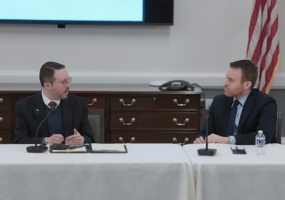 During the recent Monthly Business Briefing jointly presented by the PA Chamber and the Pennsylvania Manufacturers’ Association, Dr. Kyle Kopko, Executive Director of the Center for Rural PA, shed light on the Commonwealth’s shifting population demographics.
During the recent Monthly Business Briefing jointly presented by the PA Chamber and the Pennsylvania Manufacturers’ Association, Dr. Kyle Kopko, Executive Director of the Center for Rural PA, shed light on the Commonwealth’s shifting population demographics.
The Center for Rural PA is a legislative agency of the Pennsylvania General Assembly, functioning as a research institution and think tank that provides data and analysis to state lawmakers as well as community stakeholders such as educational institutions, municipalities, and industry associations.
Kopko explained that the definition of “rural” is based on population density and that, by this measure, approximately three-quarters of the state’s landmass is considered rural. Data released by the Center indicates that, over the next several decades, Pennsylvania will be entering a period of what Kopko described as “population stagnation.”
He explained that while the state’s population is expected to grow by a modest 1.6 percent by 2050, most counties in rural Pennsylvania are expected to lose between five and six percent of their population over the same period. As a corollary, urban areas are expected to grow by an average of four percent.
Most of the population growth that will occur in the coming decades is expected to take place in the southeastern portion of the state. Kopko noted that this growth is not limited to Philadelphia and the collar counties but applies broadly to areas south and east of the I-81 and I-78 corridors.
Kopko emphasized that policymakers need to think about population change more intentionally, as these trends will have profound effects on the workforce and hiring availability going forward. He identified two primary causes for the population shifts outlined in his presentation: 1) the “aging up” of the baby boomer generation and 2) comparatively low birth rates in successive generations.
“We are looking at almost 600,000 more senior citizens in 2030 than we had in 2020,” Kopko said. “We will also have a smaller cohort of young people following them up to take their place.”
He predicted that, soon, most Pennsylvania counties will have more senior citizens than residents under the age of 20. As of 2020, there were 26 counties that fit this description, but by the end of the decade, 53 of the state’s 67 counties will have more seniors than young people.
Furthermore, Kopko said that before the pandemic, only three counties in Pennsylvania were at or above the replacement fertility rate. All other counties had fallen below, something demographers are seeing reflected nationwide.
While demographic challenges are arguably more acute in Pennsylvania, these trends are largely happening across the entire United States and especially across the northeast. On the positive side, Kopko pointed out that Pennsylvania boasts several assets and amenities that make it attractive for residents of other states to migrate in and contribute to population growth.
One of the key themes of his presentation is that “we will need every tool at our disposal to ensure Pennsylvania can be competitive going forward.” Kopko pointed to the importance of expanding high-speed broadband connectivity amid other reforms aimed at attracting residents to the state.